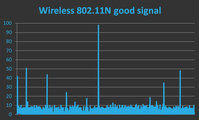- Joined
- Dec 31, 2004
- Messages
- 20,876
- Reaction score
- 435
Valve have released a series of four announcement posts on the official Steam In-Home Streaming Steam Community group detailing some of the technical aspects of the upcoming streaming service.
The system, which will become a built in part of Steam and SteamOS, will allow any user with two computers running Steam to run a game on one computer while playing it from the other. This will allow users to, for example, play a high-end AAA game on their laptop in their bedroom by streaming it from their gaming rig elsewhere in their home. It will also allow users with a Steam Machine hooked up to their living room TV to play Windows-exclusive games from their couch (without having to drag their desktop tower over to their TV).

[box=right] Valve label your axes![/box]In the second and third posts Valve go into the detail of responsiveness; the amount of time between a player pushing a button and the result of that action showing up on the screen. Unsurprisingly the home network setup plays a large part in this. Computers connected by a wired network can see latencies of around 0.5 milliseconds while wireless signals at good strength can generally get under 10 ms (but with spikes) and a wireless network at weak strength varies wildly with frequent spikes between 20 and 100 ms, a latency that would become quite noticeable in a fast paced action game.
Valve label your axes![/box]In the second and third posts Valve go into the detail of responsiveness; the amount of time between a player pushing a button and the result of that action showing up on the screen. Unsurprisingly the home network setup plays a large part in this. Computers connected by a wired network can see latencies of around 0.5 milliseconds while wireless signals at good strength can generally get under 10 ms (but with spikes) and a wireless network at weak strength varies wildly with frequent spikes between 20 and 100 ms, a latency that would become quite noticeable in a fast paced action game.
The announcements close off with a short note that Valve will be beta testing this feature to the public soon. Beta invites will be sent out to members of the official In-Home Streaming group so make sure to sign up if you want to try it out before it's officially rolled out.
The system, which will become a built in part of Steam and SteamOS, will allow any user with two computers running Steam to run a game on one computer while playing it from the other. This will allow users to, for example, play a high-end AAA game on their laptop in their bedroom by streaming it from their gaming rig elsewhere in their home. It will also allow users with a Steam Machine hooked up to their living room TV to play Windows-exclusive games from their couch (without having to drag their desktop tower over to their TV).
[box=right]
 Valve label your axes![/box]In the second and third posts Valve go into the detail of responsiveness; the amount of time between a player pushing a button and the result of that action showing up on the screen. Unsurprisingly the home network setup plays a large part in this. Computers connected by a wired network can see latencies of around 0.5 milliseconds while wireless signals at good strength can generally get under 10 ms (but with spikes) and a wireless network at weak strength varies wildly with frequent spikes between 20 and 100 ms, a latency that would become quite noticeable in a fast paced action game.
Valve label your axes![/box]In the second and third posts Valve go into the detail of responsiveness; the amount of time between a player pushing a button and the result of that action showing up on the screen. Unsurprisingly the home network setup plays a large part in this. Computers connected by a wired network can see latencies of around 0.5 milliseconds while wireless signals at good strength can generally get under 10 ms (but with spikes) and a wireless network at weak strength varies wildly with frequent spikes between 20 and 100 ms, a latency that would become quite noticeable in a fast paced action game.The announcements close off with a short note that Valve will be beta testing this feature to the public soon. Beta invites will be sent out to members of the official In-Home Streaming group so make sure to sign up if you want to try it out before it's officially rolled out.




